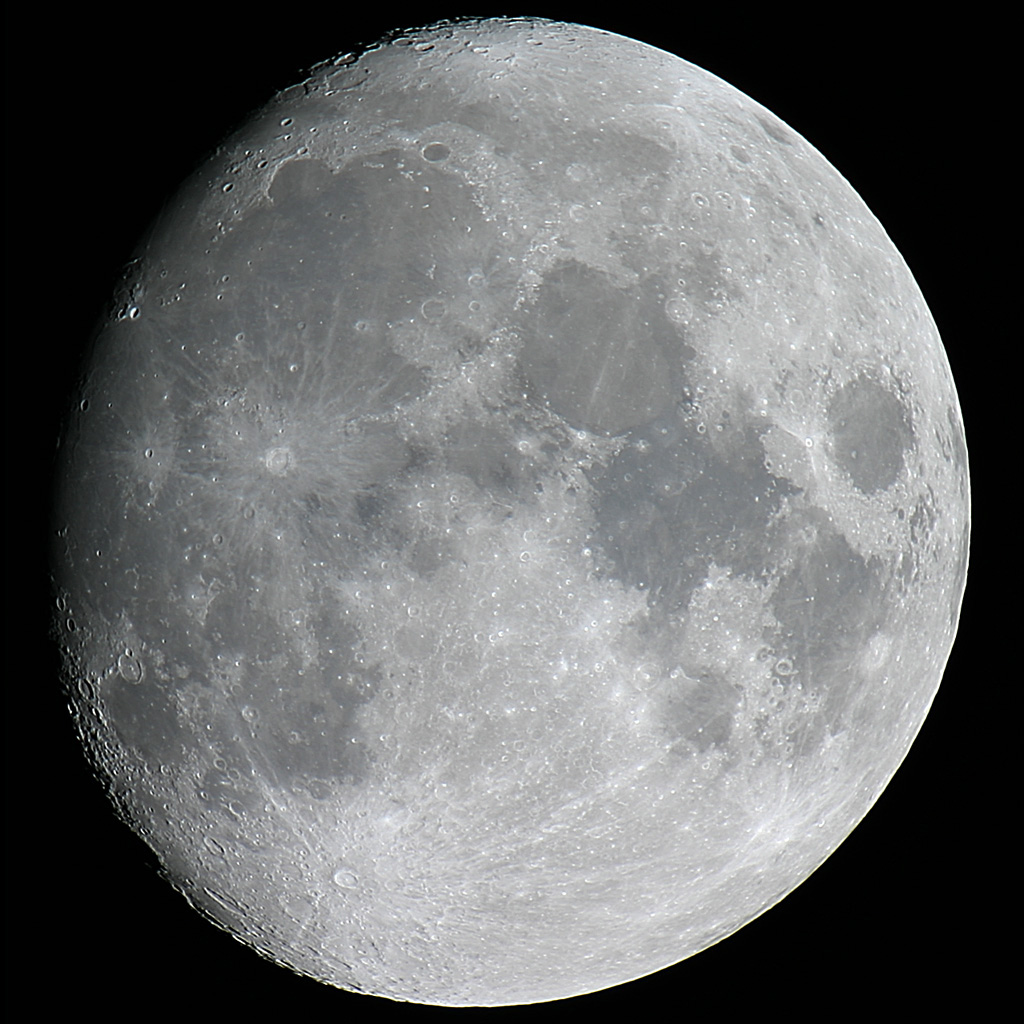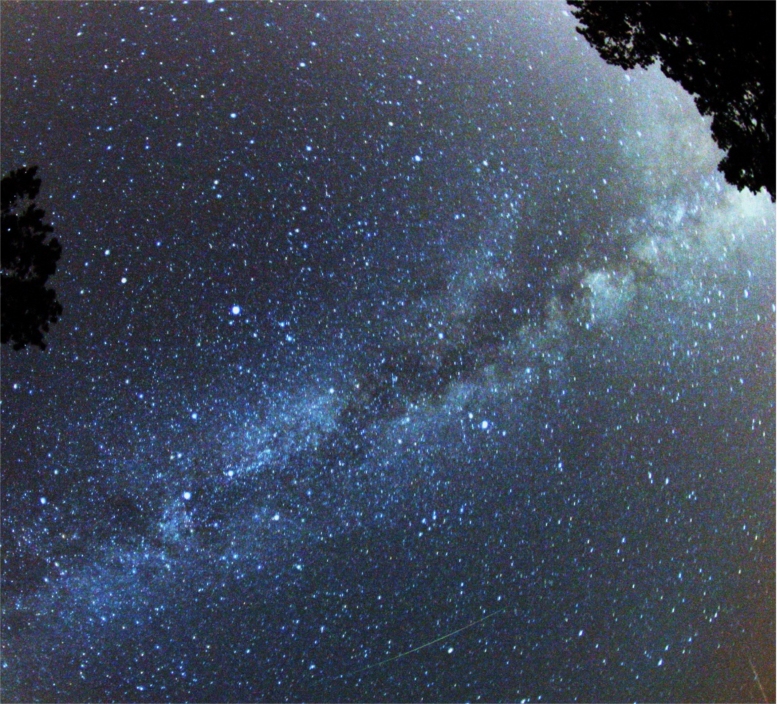|
Earthshine
Earthlight is the diffuse reflection of sunlight reflected from Earth's surface and clouds. Earthshine (an example of planetshine), also known as the Moon's ashen glow, is the dim illumination of the otherwise unilluminated portion of the Moon by this indirect sunlight. Earthlight on the Moon during the waxing crescent is called "the old Moon in the new Moon's arms", while that during the waning crescent is called "the new Moon in the old Moon's arms". Earthlight has a calculated maximum apparent magnitude of −17.7 as viewed from the Moon. Earthshine has a calculated maximum apparent magnitude of −3.69 as viewed from Earth. This phenomenon is most visible from Earth at night (or astronomical twilight) a few days before or after the day of new moon, when the lunar phase is a thin crescent. On these nights, the entire lunar disk is both directly and indirectly sunlit, and is thus unevenly bright enough to see. Earthshine is most clearly seen after dusk during the waxing cresc ... [...More Info...] [...Related Items...] OR: [Wikipedia] [Google] [Baidu] |
Planetshine
Planetshine is the dim illumination, by sunlight reflected from a planet, of all or part of the otherwise dark side of any moon orbiting the body. Planetlight is the diffuse reflection of sunlight from a planet, whose albedo can be measured. The most observed and familiar example of planetshine is earthshine on the Moon, which is most visible from the night side of Earth when the lunar phase is crescent or nearly new, without the atmospheric brightness of the daytime sky. Typically, this results in the dark side of the Moon being bathed in a faint light. Planetshine has also been observed elsewhere in the Solar System. In particular, the ''Cassini'' space probe used Saturn's shine to image portions of the planet's moons, even when they do not reflect direct sunlight. The '' New Horizons'' space probe similarly used Charon's shine to discover albedo variations on Pluto's dark side. Although using a geocentric model in 510 AD, Indian mathematician and astronomer Aryabhata wa ... [...More Info...] [...Related Items...] OR: [Wikipedia] [Google] [Baidu] |
Lunar Phase
Concerning the lunar month of ~29.53 days as viewed from Earth, the lunar phase or Moon phase is the shape of the Moon's directly sunlit portion, which can be expressed quantitatively using areas or angles, or described qualitatively using the terminology of the 4 major phases: new moon, first quarter, full moon, last quarter and 4 minor phases: waxing crescent, waxing gibbous, waning gibbous, and waning crescent. The lunar phases gradually change over a synodic month (~29.53 days) as the Moon's orbital positions around Earth and Earth around the Sun shift. The visible side of the Moon is variously sunlit, depending on the position of the Moon in its orbit. Thus, this face's sunlit portion can vary from 0% (at new moon) to 100% (at full moon). Each of the 4 major lunar phases (see below) is ~7.4 days, with +/− 19 hours in variation (6.58–8.24 days) due to the elliptical shape of the Moon's orbit. Phases of the Moon There are four ''principal'' (primary/major) lunar phase ... [...More Info...] [...Related Items...] OR: [Wikipedia] [Google] [Baidu] |
Moon
The Moon is Earth's only natural satellite. It is the fifth largest satellite in the Solar System and the largest and most massive relative to its parent planet, with a diameter about one-quarter that of Earth (comparable to the width of Australia). The Moon is a planetary-mass object with a differentiated rocky body, making it a satellite planet under the geophysical definitions of the term and larger than all known dwarf planets of the Solar System. It lacks any significant atmosphere, hydrosphere, or magnetic field. Its surface gravity is about one-sixth of Earth's at , with Jupiter's moon Io being the only satellite in the Solar System known to have a higher surface gravity and density. The Moon orbits Earth at an average distance of , or about 30 times Earth's diameter. Its gravitational influence is the main driver of Earth's tides and very slowly lengthens Earth's day. The Moon's orbit around Earth has a sidereal period of 27.3 days. During each synodic period ... [...More Info...] [...Related Items...] OR: [Wikipedia] [Google] [Baidu] |
Apparent Magnitude
Apparent magnitude () is a measure of the brightness of a star or other astronomical object observed from Earth. An object's apparent magnitude depends on its intrinsic luminosity, its distance from Earth, and any extinction of the object's light caused by interstellar dust along the line of sight to the observer. The word ''magnitude'' in astronomy, unless stated otherwise, usually refers to a celestial object's apparent magnitude. The magnitude scale dates back to the ancient Roman astronomer Claudius Ptolemy, whose star catalog listed stars from 1st magnitude (brightest) to 6th magnitude (dimmest). The modern scale was mathematically defined in a way to closely match this historical system. The scale is reverse logarithmic: the brighter an object is, the lower its magnitude number. A difference of 1.0 in magnitude corresponds to a brightness ratio of \sqrt /math>, or about 2.512. For example, a star of magnitude 2.0 is 2.512 times as bright as a star of magnitude 3.0, 6. ... [...More Info...] [...Related Items...] OR: [Wikipedia] [Google] [Baidu] |
Astronaut
An astronaut (from the Ancient Greek (), meaning 'star', and (), meaning 'sailor') is a person trained, equipped, and deployed by a human spaceflight program to serve as a commander or crew member aboard a spacecraft. Although generally reserved for professional space travelers, the term is sometimes applied to anyone who travels into space, including scientists, politicians, journalists, and tourists. "Astronaut" technically applies to all human space travelers regardless of nationality. However, astronauts fielded by Russia or the Soviet Union are typically known instead as cosmonauts (from the Russian "kosmos" (космос), meaning "space", also borrowed from Greek). Comparatively recent developments in crewed spaceflight made by China have led to the rise of the term taikonaut (from the Mandarin "tàikōng" (), meaning "space"), although its use is somewhat informal and its origin is unclear. In China, the People's Liberation Army Astronaut Corps astronauts and their ... [...More Info...] [...Related Items...] OR: [Wikipedia] [Google] [Baidu] |
Lunar Observation
The Moon is the largest natural satellite of and the closest major astronomical object to Earth. The Moon may be observed by using a variety of optical instruments, ranging from the naked eye to large telescopes. The Moon is the only celestial body upon which surface features can be discerned with the unaided eyes of most people. Optimal viewing times Contrary to popular belief, the Moon should ideally not be viewed at its full phase. During a full moon, rays of sunlight are hitting the visible portion of the Moon perpendicular to the surface. As a result, there is less surface detail visible during a full moon than during other phases (such as the quarter and crescent phases) when sunlight hits the Moon at a much shallower angle. The brightness of a full moon as compared to a phase where a smaller percentage of the surface is illuminated tends to wash out substantial amounts of detail and can actually leave an afterimage on an observer's eye that can persist for several minute ... [...More Info...] [...Related Items...] OR: [Wikipedia] [Google] [Baidu] |
Sunlight
Sunlight is a portion of the electromagnetic radiation given off by the Sun, in particular infrared, visible, and ultraviolet light. On Earth, sunlight is scattered and filtered through Earth's atmosphere, and is obvious as daylight when the Sun is above the horizon. When direct solar radiation is not blocked by clouds, it is experienced as sunshine, a combination of bright light and radiant heat. When blocked by clouds or reflected off other objects, sunlight is diffused. Sources estimate a global average of between 164 watts to 340 watts per square meter over a 24-hour day; this figure is estimated by NASA to be about a quarter of Earth's average total solar irradiance. The ultraviolet radiation in sunlight has both positive and negative health effects, as it is both a requisite for vitamin D3 synthesis and a mutagen. Sunlight takes about 8.3 minutes to reach Earth from the surface of the Sun. A photon starting at the center of the Sun and changing direction eve ... [...More Info...] [...Related Items...] OR: [Wikipedia] [Google] [Baidu] |
Moonlight
Moonlight consists of mostly sunlight (with little earthlight) reflected from the parts of the Moon's surface where the Sun's light strikes. Illumination The intensity of moonlight varies greatly depending on the lunar phase, but even the full Moon typically provides only about 0.05–0.1 lux illumination. When a full Moon around perigee (a "supermoon") is viewed around upper culmination from the tropics, the illuminance can reach up to 0.32 lux. From Earth, the apparent magnitude of the full Moon is only about that of the Sun. The color of moonlight, particularly around full moon, appears bluish to the human eye compared to other, brighter light sources due to the Purkinje effect. The blue or silver appearance of the light is an illusion. The Moon's bond albedo is 0.12, meaning only 12% of incident sunlight is reflected from the lunar surface. Moonlight takes approximately 1.26 seconds to reach Earth's surface. Scattered in Earth's atmosphere, moonlight genera ... [...More Info...] [...Related Items...] OR: [Wikipedia] [Google] [Baidu] |
Starlight
Starlight is the light emitted by stars. It typically refers to visible electromagnetic radiation from stars other than the Sun, observable from Earth at night, although a component of starlight is observable from Earth during daytime. Sunlight is the term used for the Sun's starlight observed during daytime. During nighttime, albedo describes solar reflections from other Solar System objects, including moonlight, planetshine, and zodiacal light. Observation Observation and measurement of starlight through telescopes is the basis for many fields of astronomy, including photometry and stellar spectroscopy. Hipparchus did not have a telescope or any instrument that could measure apparent brightness accurately, so he simply made estimates with his eyes. He sorted the stars into six brightness categories, which he called magnitudes.''Astronomy''. https://d3bxy9euw4e147.cloudfront.net/oscms-prodcms/media/documents/Astronomy-Draft-20160817.pdf: Rice University. 2016. p. 761. - via ... [...More Info...] [...Related Items...] OR: [Wikipedia] [Google] [Baidu] |
List Of Light Sources
This is a list of sources of light, the visible part of the electromagnetic spectrum. Light sources produce photons from another energy source, such as heat, chemical reactions, or conversion of mass or a different frequency of electromagnetic energy, and include light bulbs and stars like the Sun. Reflectors (such as the moon, cat's eyes, and mirrors) do not actually produce the light that comes from them. Incandescence Incandescence is the emission of light from a hot body as a result of its temperature. * * Combustion Lamps * (obsolete) * * * * (error) * * * * *s *s * (obsolete) *s * Other * * * *s * * * * * * * * * Nuclear and high-energy particle * * ** ** * * * * * Celestial and atmospheric *Astronomical objects **Sun (sunlight, solar radiation) *** *** **Star (Starlight) ***Nova / supernova / hypernova *** **** *** ** *** *** *** *** *** * **Meteor *** ** *** *Lightning (Plasma) ** ** ** ** * * Luminescence Luminescence is emissio ... [...More Info...] [...Related Items...] OR: [Wikipedia] [Google] [Baidu] |
Earth–Moon–Earth Communication
Earth–Moon–Earth communication (EME), also known as Moon bounce, is a radio communications technique that relies on the propagation of radio waves from an Earth-based transmitter directed via reflection from the surface of the Moon back to an Earth-based receiver. History The use of the Moon as a passive communications satellite was proposed by W.J. Bray of the British General Post Office in 1940. It was calculated that with the available microwave transmission powers and low noise receivers, it would be possible to beam microwave signals up from Earth and reflect them off the Moon. It was thought that at least one voice channel would be possible. Radar reflections off the moon were received and recognized as such in 1943 during German experiments with radio measurement equipment, as reported by Dr. Ing. W. Stepp in the "Der Seewart" magazine. Stepp noted a "perturbation", which "appeared, had a duration of several impulses, and larger impulse strength than the strongest ... [...More Info...] [...Related Items...] OR: [Wikipedia] [Google] [Baidu] |




.jpg)




